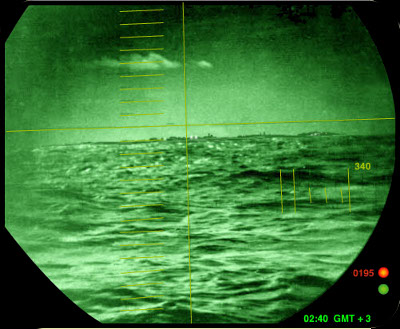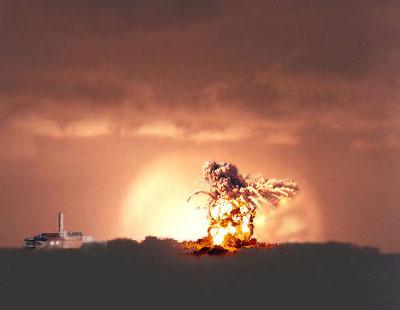
International Aerial Robotics Competition
The 4th Mission involved demonstration of fully autonomous flight over a large area in an attempt to perform a mission that fits into three scenarios. Each example is of interest to a different potential user, however the behaviors required are identical for each mission example.

Darkness is upon the face of the deep as a breeze moves silently over the surface of the waters. Suddenly a periscope is thrust through the still boundary that divides the waters from heavens. Low on the horizon are the twinkling lights of a coastal city. In that city lies an embassy in which the diplomatic staff is being detained by a terrorist group known as the "Independent Anarchist Rebel Coalition".
The periscope scans the dark surface for vessels— none are detected. Soon, the Spesialkommando Elite Assault League 6 (SEAL-6) will deploy from the submarine to take control of the embassy and free the hostages. First however, an aerial sensor probe will be launched from the submarine to determine how many terrorists are guarding the hostages. The submarine lies three kilometers from the city in deep water. The embassy is near the waterfront and is identifiable by two great lights illuminating the national seal over the main entrance which is an image in the likeness of a circle with a cross at the center. Because this incident is occurring in a tropical third world nation, the embassy will have some of its windows open to the evening air.
Your mission is to have an autonomous aerial robot carry sensors from the location of the submarine to the embassy, and then covertly enter the embassy to provide a picture of the hostages and their captors that can be viewed back on the submarine. This information must be obtained as quickly as possible so that SEAL-6 will know the location and size of the threat before a rescue attempt is made. The reconnaissance mission must be completed within 15 minutes of launch from the submarine in order to maintain the element of surprise.

April 26, 1:23:44 hrs Greenwich mean time. Let there be light: and there was light. A great fire ball illuminates the night followed seconds later by the sound of a thunderous explosion. A catastrophe of unknown cause or extent has occurred in Unit #4 of the Ukrainistan nuclear reactor complex. All that is seen now is the dull red glow of burning graphite from the KMBR-1000 reactor.
There are no survivors within the facility. Radioactive elements of Iodine-131, Cesium-137, and Strontium-90 are present in lethal levels. A safe distance for human investigative teams has been determined to be no closer than three kilometers. Units #1 and #3 have apparently shut down automatically, but Unit #2 is still operating, possibly due to a fault in the control system that makes the emergency shutdown unable to function. Long distance aerial photography indicates that the overpressure from the explosion has blown out all windows in the facility.
Your mission is to have an autonomous aerial robot carry sensors from a safe location (three kilometers distant from the complex) to the control room of Unit #2 which is identifiable by two great lights illuminating the Ukrainistani national seal over the main entrance. The seal is an image in the likeness of crossed swords within a circle. Sensors must enter the control room to provide a picture of the main control panel gauges and switch positions so experts can see why Unit #2 has not shut down and assess the potential for a meltdown of this unit. The reconnaissance mission must be completed within 15 minutes of launch from the three kilometer safety perimeter due to expected radiation-induced failures within the aerial robot's systems.

During archaeological excavations near Athena Greco, a necropolis dating back to 425 BC was discovered containing seven mausoleums. Each mausoleum consisted of several catacomb-like chambers. Only two of the mausoleum buildings remain intact. Soon after the discovery, the archaeologists fell ill, at first with strong fevers accompanied by redness and burning of the eyes, followed by vomiting of blood. Within one hour, victims' skin became severely ulcerated and bleeding was observed from all openings of the body. No personnel having direct contact with the site have survived longer than 4 hours.
A team from the CDZ and the US Army Medical Research Academy for Infectious Disease (USAMRAID) set up a field laboratory where they determined the cause of the epidemic to be a new strain of the Ebola virus. Dr. Jackson Gilbertman of the CDZ in Atlanta has reported that this is the most lethal strain of the virus investigated to date. In an interview earlier this week, Dr. Gilbertman stated that, "This is not really a new mutated strain of Ebola, but most likely an ancient strain that has been locked away in the Athenan tombs for almost twenty five hundred years."
What is most disconcerting, is the finding that this "new" (ancient) strain, dubbed "Ebola-A425", exhibits increasing evidence for possible airborne transmission. According to Dr. Gilbertman, "Researchers from USAMRAID have done formal aerosol experiments in which as little as 400 plague-forming units of Ebola-A425 caused a fatal disease in monkeys within four to five hours. All exposed monkeys developed Ebola-related pneumonia, and virus particles were found in many different areas of the respiratory system."
No one who entered the mausoleum chambers remains alive. A three kilometer quarantine radius around the site has been ordered by the government. In order to contain the outbreak, no one is allowed to enter or leave this perimeter. National Guard units from the Greco Ministry of Defense have been sent to the quarantine zone to suppress rioting that is on-going in the villages of Phaetalos and Necros which reside just inside the perimeter. The Greco government has appealed through the United Federation of Nations for assistance in eradicating the threat by disinfecting the surface of the earth around the site through the use of a controlled fuel-air explosion, however the overpressure of the blast will destroy the mausoleum and its burial chambers. As recounted in a final transmission from the archaeological team prior to the sudden and violent death of its members, valuable and undocumented inscriptions on a hanging tapestry are contained over the most prominent sepulcher within one of the interior chambers. Above the entrance to the mausoleum containing the tapestry is the symbol for the sun god 'Ar' with rays pointing to the cardinal points and inscribed within the circle of life. Two great lights were set in place by the archaeologists to illuminate the front of this particular mausoleum for night excavations, and these are known to be operating still.
Your mission is to have an autonomous aerial robot carry sensors from the three kilometer perimeter into the mausoleum where it will locate the tapestry and relay pictures of the inscriptions back to scientists for analysis and translation. Because of delays in obtaining approval to conduct this mission, the reconnaissance run must be completed within 15 minutes of launch from the three kilometer safety perimeter due to the scheduled purifying explosion.
 ABES Engineering College: Ghaziabad, Uttar Pradesh, India
ABES Engineering College: Ghaziabad, Uttar Pradesh, India Army Institute of Technology & University of Pune: Pune, Maharashtra, India
Army Institute of Technology & University of Pune: Pune, Maharashtra, India California State University, Northridge: Northridge, California, United States
California State University, Northridge: Northridge, California, United States Delhi College of Engineering, University of Delhi: Shahbad Daulatpur, Delhi, India
Delhi College of Engineering, University of Delhi: Shahbad Daulatpur, Delhi, India DeVry Calgary: Calgary, Alberta, Canada
DeVry Calgary: Calgary, Alberta, Canada École de Technologie Supérieure: Montréal, Quebec, Canada
École de Technologie Supérieure: Montréal, Quebec, Canada Georgia Institute of Technology: Atlanta, Georgia, United States
Georgia Institute of Technology: Atlanta, Georgia, United States LeTourneau University: Longview, Texas, United States
LeTourneau University: Longview, Texas, United States Mesa State College: Grand Junction, Colorado, United States
Mesa State College: Grand Junction, Colorado, United States North Carolina State University: Releigh, North Carolina, United States
North Carolina State University: Releigh, North Carolina, United States Ohio State University: Columbus, Ohio, United States
Ohio State University: Columbus, Ohio, United States Pima Community College: Tucson, Arizona, United States
Pima Community College: Tucson, Arizona, United States Purdue University: West Lafayette, Indiana, United States
Purdue University: West Lafayette, Indiana, United States Rose-Hulman Institute of Technology: Terre Haute, Indiana, United States
Rose-Hulman Institute of Technology: Terre Haute, Indiana, United States Simon Fraser University: Burnaby, British Columbia, Canada
Simon Fraser University: Burnaby, British Columbia, Canada South Dakota School of Mines and Technology: Rapid City, South Dakota, United States
South Dakota School of Mines and Technology: Rapid City, South Dakota, United States Southern Polytechnic State University: Marietta, Georgia, United States
Southern Polytechnic State University: Marietta, Georgia, United States University of Alabama in Huntsville: Huntsville, Alabama, United States
University of Alabama in Huntsville: Huntsville, Alabama, United States University of Arizona: Tucson, Arizona, United States
University of Arizona: Tucson, Arizona, United States University of Calgary: Calgary, Alberta, Canada
University of Calgary: Calgary, Alberta, Canada University of Central Florida: Orlando, Florida, United States
University of Central Florida: Orlando, Florida, United States University of Iowa: Des Moines, Iowa, United States
University of Iowa: Des Moines, Iowa, United States University of New Mexico: Albuquerque, New Mexico, United States
University of New Mexico: Albuquerque, New Mexico, United States University of Ottawa: Ottawa, Ontario, Canada
University of Ottawa: Ottawa, Ontario, Canada University of Texas at Austin: Austin, Texas, United States
University of Texas at Austin: Austin, Texas, United States University of Waterloo: Waterloo, Ontario, Canada
University of Waterloo: Waterloo, Ontario, Canada Virginia Polytechnic Institute and State University: Blacksburg, Virginia, United States
Virginia Polytechnic Institute and State University: Blacksburg, Virginia, United States